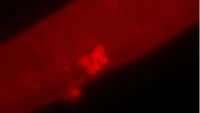Cause of rare childhood cancer discovered

Scientists have made a breakthrough in understanding the cause of a rare childhood muscle cancer, called Rhabdomyosarcoma (RMS).
The discovery could lead to the development of improved therapies to treat the disease and other types of cancer in the future.
Around 60 and 350 new cases of RMS are diagnosed in the UK and Europe/US respectively, each year. Most RMS tumours occur in children younger than 10 years old.
A collaborative study led by scientists from Harvard University and involving experts from the University of Aberdeen, has revealed for the first time the key role a protein called Yap plays in triggering RMS.
Dr Annie Tremblay from Harvard University said: “RMS is a muscle cancer that can arise from any skeletal muscles in the body, although approximately 40% of the cases arise in the head and neck regions.
“The current therapies for RMS, although relatively efficient, are very aggressive and drastically alter the quality-of-life of the children who survive. Indeed, most of the survivors will suffer life-altering consequences ranging from loss of mobility and/or vision, to life-long hormone replacement therapies only to go through puberty and live a normal life.
“We discovered that in cases of the disease, excessive activity of a protein called Yap causes muscle stem cells to permanently divide instead of stopping and becoming normal muscle tissue.
“Yap does that by inhibiting the activity of muscle determination proteins, which are key to the formation of muscle tissue.
“In contrast to normal muscle stem cells, the high Yap muscle stem cells fail to develop into normal muscle tissue and Rhabdomyosarcoma develops as a consequence.”
Our identification of the Yap protein's crucial role in the development of Rhabdomyosarcoma is the first step on the road towards understanding how we can target this rare disease." - Dr Henning Wackerhage
During normal muscle development, stem cells turn into developmental muscle cells - called myoblasts -that divide, before finally fusing together to form long muscle fibres.
The Yap protein is fundamental to this process, with the myoblasts experiencing a marked increase in its activity during the division stage. Once enough myoblasts are present, Yap gets turned off which allows them to stop dividing and fuse together to form functional muscles.
Findings from the study show that in instances of Rhabdomyosarcoma cancer, the Yap protein remains active in the myoblasts –like the accelerator of a car being stuck.
By combining the results from animal models with histological and bioinformatical approaches using human RMS samples, researchers at the University of Aberdeen, the Swiss bioinformatics institute and the Institute of Cancer Research additionally showed that Yap is actually hyper-active in a large proportion of human RMS cases.
Dr Henning Wackerhage said: “Our identification of the Yap protein’s crucial role in the development of Rhabdomyosarcoma is the first step on the road towards understanding how we can target this rare disease.
“Our work will now focus on how the Yap protein works in cancer and how its activity can be controlled.
“If we can achieve the inhibition of inhibit Yap locally in the tumours, we could cause the cancer to stop and regress by turning the RMS into normal muscle instead. This would most likely produce significantly fewer side effects than the current therapies.”
“Other research has shown that Yap is active in several other types of cancer including liver and skin cancers. These results could therefore be of wider significance in also enhancing our global understanding of the role of Yap in cancer.”
The three year study was supported by funding from Aberdeen charity, Friends of Anchor, Sarcoma UK, the Medical Research Council and the Canadian Institutes of Health Research.

